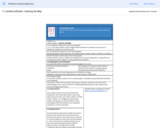
An engaging lesson using Dash robot to help students identify and describe different attributes of landforms.
- Subject:
- Applied Science
- Computer Science
- Social Studies
- Material Type:
- Activity/Lab
- Date Added:
- 03/17/2023

An engaging lesson using Dash robot to help students identify and describe different attributes of landforms.

Students learn that fats found in the foods we eat are not all the same; they discover that physical properties of materials are related to their chemical structures. Provided with several samples of commonly used fats with different chemical properties (olive oil, vegetable oil, shortening, animal fat and butter), student groups build and use simple LEGO MINDSTORMS(TM) NXT robots with temperature and light sensors to determine the melting points of the fat samples. Because of their different chemical structures, these fats exhibit different physical properties, such as melting point and color. This activity uses the fact that fats are opaque when solid and translucent when liquid to determine the melting point of each sample upon being heated. Students heat the samples, and use the robot to determine when samples are melted. They analyze plots of their collected data to compare melting points of the oil samples to look for trends. Discrepancies are correlated to differences in the chemical structure and composition of the fats.
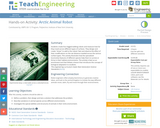
Students create four-legged walking robots and measure how far they travel across different types of surfaces. They design and create "shoes" to add to the robots' feet and observe the effect of their modifications on the net distance traveled across the various surface types. This activity illustrates how the specialized locomotive features of different species help them to survive or thrive in their habitat environments. The activity is best as an enrichment tool that follows a lesson that introduces the concept of biological adaptation to students.
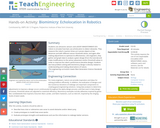
Students use ultrasonic sensors and LEGO© MINDSTORMS© NXT robots to emulate how bats use echolocation to detect obstacles. They measure the robot's reaction times as it senses objects at two distances and with different sensor threshold values, and again after making adjustments to optimize its effectiveness. Like engineers, they gather and graph data to analyze a given design (from the tutorial) and make modifications to the sensor placement and/or threshold values in order to improve the robot's performance (iterative design). Students see how problem solving with biomimicry design is directly related to understanding and making observations of nature.
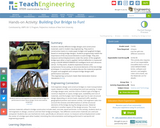
Students identify different bridge designs and construction materials used in modern day engineering. They work in construction teams to create paper bridges and spaghetti bridges based on existing bridge designs. Students progressively realize the importance of the structural elements in each bridge. They also measure vertical displacements under the center of the spaghetti bridge span when a load is applied. Vertical deflection is measured using a LEGO MINDSTORMS(TM) NXT intelligent brick and ultrasonic sensor. As they work, students experience tension and compression forces acting on structural elements of the two bridge prototypes. In conclusion, students discuss the material properties of paper and spaghetti and compare bridge designs with performance outcomes.
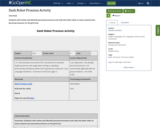
Students will review and identify personal pronouns and code the Dash robot to move toward each personal pronoun on the grid mat.
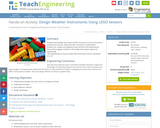
Student teams design and create LEGO® structures to house and protect temperature sensors. They leave their structures in undisturbed locations for a week, and regularly check and chart the temperatures. This activity engages students in the design and analysis aspects of engineering.
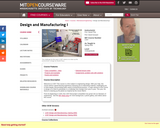
Welcome to 2.007! This course is a first subject in engineering design. With your help, this course will be a great learning experience exposing you to interesting material, challenging you to think deeply, and providing skills useful in professional practice. A major element of the course is design of a robot to participate in a challenge that changes from year to year. This year, the theme is cleaning up the planet as inspired by the movie Wall-E.
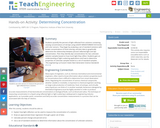
Students quantify the percent of light reflected from solutions containing varying concentrations of red dye using LEGO© MINDSTORMS© NXT bricks and light sensors. They begin by analyzing a set of standard solutions with known concentrations of food coloring, and plot data to graphically determine the relationship between percent reflected light and dye concentration. Then they identify dye concentrations for two unknown solution samples based on how much light they reflect. Students gain an understanding of light scattering applications and how to determine properties of unknown samples based on a set of standard samples.
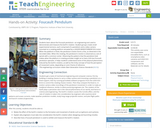
Students learn about the Foucault pendulum an engineering tool used to demonstrate and measure the Earth's rotation. Student groups create small experimental versions, each comprised of a pendulum and a video camera mounted on a rotating platform actuated by a LEGO MINDSTORMS(TM) NXT motor. When the platform is fixed, the pendulum motion forms a line, as observed in the recorded video. When the rotating, the pendulum's motion is observed as a set of spirals with a common center. Observing the patterns that the pendulum bob makes when the platform is rotating provides insight as to how a full-size Foucault pendulum operates. It helps students understand some of the physical phenomena induced by the Earth's rotation, as well as the tricky concept of how the perception of movement varies, depending on one's frame of reference.
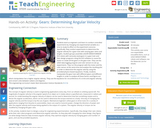
Students work as engineers and learn to conduct controlled experiments by changing one experimental variable at a time to study its effect on the experiment outcome. Specifically, they conduct experiments to determine the angular velocity for a gear train with varying gear ratios and lengths. Student groups assemble LEGO MINDSTORMS(TM) NXT robots with variously sized gears in a gear train and then design programs using the NXT software to cause the motor to rotate all the gears in the gear train. They use the LEGO data logging program and light sensors to set up experiments. They run the program with the motor and the light sensor at the same time and analyze the resulting plot in order to determine the angular velocity using the provided physics-based equations. Finally, students manipulate the gear train with different gears and different lengths in order to analyze all these factors and figure out which manipulation has a higher angular velocity. They use the equations for circumference of a circle and angular velocity; and convert units between radians and degrees.
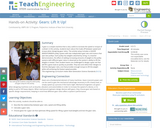
A gear is a simple machine that is very useful to increase the speed or torque of a wheel. In this activity, students learn about the trade-off between speed and torque when designing gear ratios. The activity setup includes a LEGO(TM) MINDSTORMS(TM) NXT pulley system with two independent gear sets and motors that spin two pulleys. Each pulley has weights attached by string. In a teacher demonstration, the effect of adding increasing amounts of weight to the pulley systems with different gear ratios is observed as the system's ability to lift the weights is tested. Then student teams are challenged to design a gear set that will lift a given load as quickly as possible. They test and refine their designs to find the ideal gear ratio, one that provides enough torque to lift the weight while still achieving the fastest speed possible.
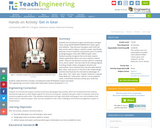
Students are introduced to gear transmissions and gear ratios using LEGO MINDSTORMS(TM) NXT robots, gears and software. They discover how gears work and how they can be used to adjust a vehicle's power. Specifically, they learn how to build the transmission part of a vehicle by designing gear trains with different gear ratios. Students quickly recognize that some tasks require vehicle speed while others are more suited for vehicle power. They are introduced to torque, which is a twisting force, and to speed the two traits of all rotating engines, including mobile robots using gears, bicycles and automobiles. Once students learn the principles behind gear ratios, they are put to the test in two simple design activities that illustrate the mechanical advantages of gear ratios. The "robot race" is better suited for a quicker robot while the "robot push" calls for a more powerful robot. A worksheet and post-activity quiz verify that students understand the concepts, including the tradeoff between torque and speed.
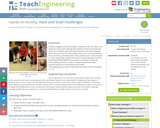
Students engage in the second design challenge of the unit, which is an extension of the maze challenge they solved in the first lesson/activity of this unit. Students extend the ideas learned in the maze challenge with a focus more on the robot design. Gears are a very important part of any machine, particularly when it has a power source such as engine or motor. Specifically, students learn how to design the gear train from the LEGO MINDSTORMS(TM) NXT servomotor to the wheel to make the LEGO taskbot go faster or slower. A PowerPoint® presentation, pre/post quizzes and a worksheet are provided.
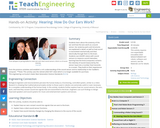
Students learn about the anatomy of the ear and how the ears work as a sound sensor. Ear anatomy parts and structures are explained in detail, as well as how sound is transmitted mechanically and then electrically through them to the brain. Students use LEGO® robots with sound sensors to measure sound intensities, learning how the NXT brick (computer) converts the intensity of sound measured by the sensor input into a number that transmits to a screen. They build on their experiences from the previous activities and establish a rich understanding of the sound sensor and its relationship to the TaskBot's computer.
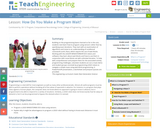
Building on the programming basics learned so far in the unit, students next learn how to program using sensors rather than by specifying exact durations. They start with an examination of algorithms and move to an understanding of conditional commands (until, then), which require the use of wait blocks. Working with the LEGO MINDSTORMS(TM) NXT robots and software, they learn about wait blocks and how to use them in conjunction with move blocks set with unlimited duration. To help with comprehension and prepare them for the associated activity programming challenges, volunteer students act out a maze demo and student groups conclude by programming LEGO robots to navigate a simple maze using wait block programming. A PowerPoint® presentation, a worksheet and pre/post quizzes are provided.
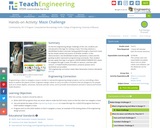
As the first engineering design challenge of the unit, students are introduced to the logic for solving a maze. First they observe a blindfolded student volunteer being guided through a classroom maze by the simple verbal instructions of another student. In this demonstration, the blindfolded student represents a robot and the guiding student represents programming commands. Then student groups apply that logic to program LEGO MINDSTORMS(TM) NXT robots to navigate through a maze, first with no sensors, and then with sensors. A PowerPoint® presentation, pre/post quizzes and a worksheet are provided.

Using the LEGO MINDSTORMS(TM) NXT kit, students construct experiments to measure the time it takes a free falling body to travel a specified distance. Students use the touch sensor, rotational sensor, and the NXT brick to measure the time of flight for the falling object at different release heights. After the object is released from its holder and travels a specified distance, a touch sensor is triggered and time of object's descent from release to impact at touch sensor is recorded and displayed on the screen of the NXT. Students calculate the average velocity of the falling object from each point of release, and construct a graph of average velocity versus time. They also create a best fit line for the graph using spreadsheet software. Students use the slope of the best fit line to determine their experimental g value and compare this to the standard value of g.

Using new knowledge acquired in the associated lesson, students program LEGO MINDSTORMS(TM) NXT robots to go through a maze using movement blocks. The maze is created on the classroom floor with cardboard boxes as its walls. Student pairs follow the steps of the engineering design process to brainstorm, design and test programs to success. Through this activity, students understand how to create and test a basic program. A PowerPoint® presentation, pre/post quizzes and worksheet are provided.
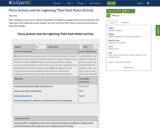
After completion of the novel, students will explore the different settings in the novel and analyze what major plot event happened at each setting. They will code their Dash robot to move across the map to locate the settings.